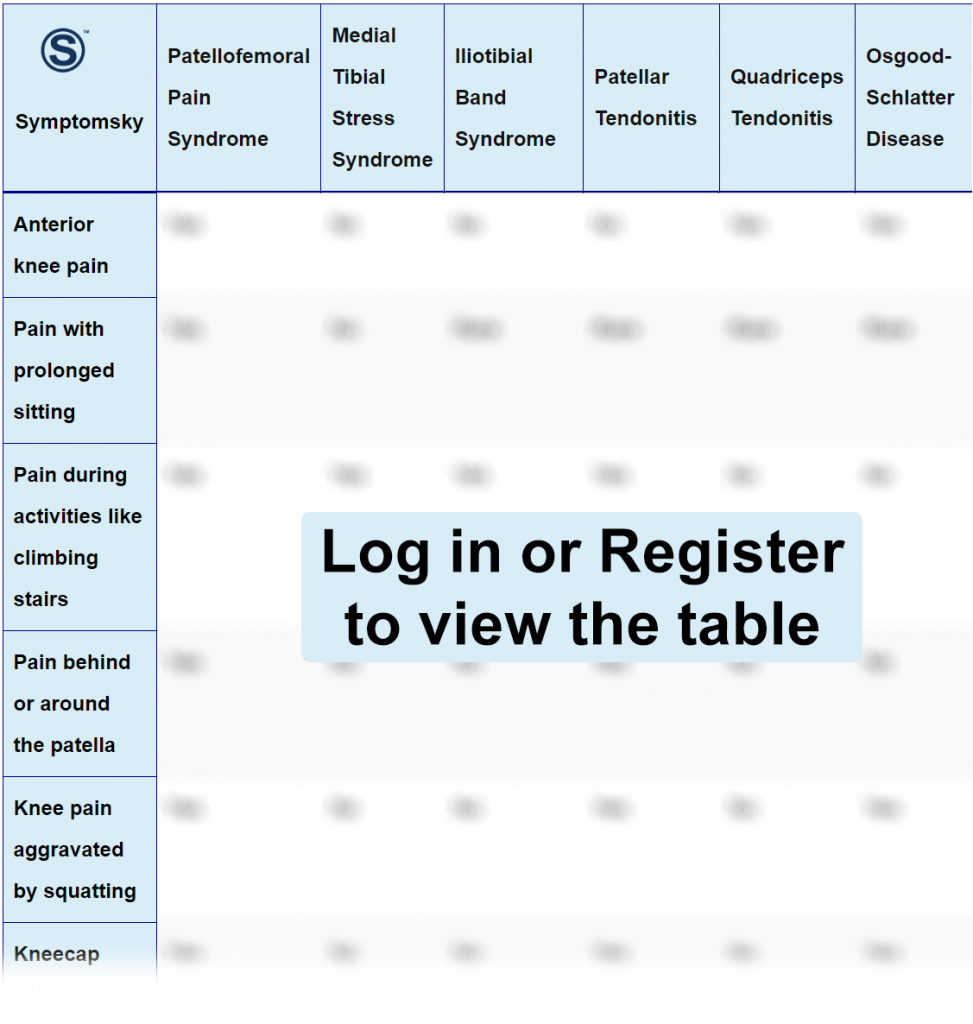Contents
- 1 Patellofemoral Disorders Differential Diagnosis Table:
- 2 How to Distinguish Patellofemoral Pain Syndrome from Other Diseases
- 2.1 Distinguish Medial Tibial Syndrome from Patellofemoral Pain Syndrome – Diagnosis
- 2.2 Distinguish Iliotibial Band Syndrome from Patellofemoral Pain Syndrome – Diagnosis
- 2.3 Distinguish Patellar Tendonitis from Patellofemoral Pain Syndrome – Diagnosis
- 2.4 Distinguish Quadriceps Tendonitis from Patellofemoral Pain Syndrome – Diagnosis
- 2.5 Distinguish Osgood-Schlatter Disease from Patellofemoral Pain Syndrome – Diagnosis
- 2.6 Distinguish Patellar Tip Syndrome from Patellofemoral Pain Syndrome – Diagnosis
- 2.7 Distinguish Osteoarthritis from Patellofemoral Pain Syndrome – Diagnosis
- 2.8 Distinguish Chondromalacia Patella from Patellofemoral Pain Syndrome – Diagnosis
- 2.9 Distinguish Meniscal Injury from Patellofemoral Pain Syndrome – Diagnosis
- 2.10 Distinguish Ligamentous Injury from Patellofemoral Pain Syndrome – Diagnosis
- 2.11 Distinguish Bursitis from Patellofemoral Pain Syndrome – Diagnosis
- 2.12 Distinguish Synovial Plica Syndrome from Patellofemoral Pain Syndrome – Diagnosis
- 2.13 Distinguish Stress Fractures from Patellofemoral Pain Syndrome – Diagnosis
- 3 Patellofemoral Syndrome Management and Treatment
Patellofemoral Disorders Differential Diagnosis Table:

Patellofemoral pain syndrome is a generalized dull pain in and/or around the patella. Pain increases during weight-bearing activities and during bending activities such as squatting and running. Squatting is considered the most sensitive physical examination finding. Also, pain deepens with descending stairs and prolonged sitting. Additionally, a clicking or grinding sound of the knee can be heard while flexing (bending and straightening) the knee. Plus, the patella is tender to touch.
How to Distinguish Patellofemoral Pain Syndrome from Other Diseases
Distinguish Medial Tibial Syndrome from Patellofemoral Pain Syndrome – Diagnosis
Medial tibial stress syndrome is an exercise-induced injury that occurs in the lower extremity.
- Medial tibial syndrome pain is over the tibia bone, while patellofemoral pain syndrome pain is generalized in the knee bone.
“MRI and Ultrasound are used for differentiation.”
Distinguish Iliotibial Band Syndrome from Patellofemoral Pain Syndrome – Diagnosis
- Iliotibial band syndrome pain is localized on the side of the knee, but Patellofemoral pain syndrome pain is generalized around the patella.
“MRI is used for differentiation.”
Distinguish Patellar Tendonitis from Patellofemoral Pain Syndrome – Diagnosis
Patellar tendonitis, “jumper’s knee,” is inflammation and small tears of the patellar tendon. The patellar tendon connects the kneecap (patella) to the shinbone (tibia).
- Patellar tendonitis affects strenuous jumping athletes, while patellofemoral pain syndrome is not related to jumping sports.
“Ultrasound is used for differentiation.”
Distinguish Quadriceps Tendonitis from Patellofemoral Pain Syndrome – Diagnosis
Quadriceps tendonitis is inflammation in the quadriceps tendon located above the kneecap.
- Quadriceps tendonitis pain worsens with leg extension, but patellofemoral pain syndrome worsens with squatting.
“Ultrasound is used for differentiation.”
Distinguish Osgood-Schlatter Disease from Patellofemoral Pain Syndrome – Diagnosis
Osgood-Schlatter disease is sudden pain of the anterior kneecap.
- Osgood-Schlatter disease pain is specified at the patellar tendon associated, but patellofemoral pain syndrome pain is dull around the patella.
“X-ray is used for differentiation.”
Distinguish Patellar Tip Syndrome from Patellofemoral Pain Syndrome – Diagnosis
- Patellar tip syndrome is localized chronic pain at the lower patella’s tip, while patellofemoral pain is generalized around the patella.
“X-ray and MRI are used for differentiation.”
Distinguish Osteoarthritis from Patellofemoral Pain Syndrome – Diagnosis
Osteoarthritis is pain in joints that can lead to the loss of the joint’s function.
- Osteoarthritis is characterized by joint stiffness and morning stiffness, which are both absent in patellofemoral pain syndrome.
- Osteoarthritis has movement restriction, but movement restriction is absent in patellofemoral pain syndrome.
- Osteoarthritis pain eases with prolonged sitting; patellofemoral pain syndrome pain increases with prolonged sitting.
“Synovial fluid analysis and X-ray are used for differentiation.”
Distinguish Chondromalacia Patella from Patellofemoral Pain Syndrome – Diagnosis
Chondromalacia patella is a pathological alteration causing softening and breaking down of cartilage under the patella.
- Chondromalacia patella has a grinding noise associated with palpable vibration; this sign is absent in patellofemoral pain syndrome.
“Clark’s sign and MRI are used for differentiation.”
Distinguish Meniscal Injury from Patellofemoral Pain Syndrome – Diagnosis
Meniscal injury is a torn meniscus. The meniscus is a C-shaped cartilage that serves as a cushion between the thigh and shin bones.
- Meniscal injury is associated with stiffness, which is absent in patellofemoral pain syndrome.
- Meniscal injury is an inability to fully extend the knee with movement restriction, but patellofemoral pain syndrome can fully extend the knee without movement restriction.
“MRI is considered the first choice for differentiation.”
Distinguish Ligamentous Injury from Patellofemoral Pain Syndrome – Diagnosis
Ligamentous injury is an injury in ligaments.
- Ligamentous injury is characterized by no pain, but patellofemoral pain syndrome is associated with pain.
“MRI and Ultrasound are used for differentiation.”
Distinguish Bursitis from Patellofemoral Pain Syndrome – Diagnosis
Bursitis is inflammation in the bursa.
- Bursitis has pain, especially at night, but patellofemoral pain syndrome has pain associated with activities.
- Bursitis has movement restrictions, unlike patellofemoral pain syndrome, which does not have movement restrictions.
“MRI is used for differentiation.”
Distinguish Synovial Plica Syndrome from Patellofemoral Pain Syndrome – Diagnosis
Synovial Plica syndrome is pain in the knees.
- Synovial plica is associated with plica pain and movement restriction, while patellofemoral pain syndrome is not associated with plica pain and movement restriction.
- Synovial plica has stiffness, unlike patellofemoral pain syndrome, which does not have stiffness.
“MRI is used for differentiation.”
Distinguish Stress Fractures from Patellofemoral Pain Syndrome – Diagnosis
Stress fractures are small cracks developing in the patella.
- Stress fractures have localized pain at the site of the fracture, unlike patellofemoral pain syndrome, which has generalized pain around the patella.
“MRI and Bone scan are used for differentiation.”
Patellofemoral Syndrome Management and Treatment
Conservative treatment is applied in all patellofemoral pain syndromes to prevent the progression of the condition. Some cases may persist for years, showing no improvement with therapy. Rehabilitation criteria are considered, including a short course of non-steroidal anti-inflammatory drugs and physical therapy to strengthen knee muscles. If the patient fails therapy for more than two months, surgery is considered. Yet, invasive measures are considered a last resort.
